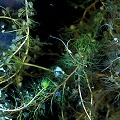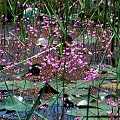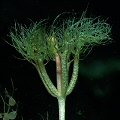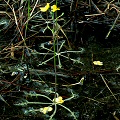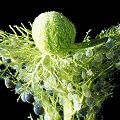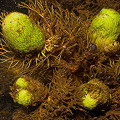Q: About suspended aquatic Utricularia
A: The term "suspended" aquatic indicates those species which are not rooted in the
ground. These are free-floating aquatic species that might be found in shallow or deep water, usually in nutrient poor sites.
Locals might call them something like "lakeweed".
Suspended aquatic Utricularia species occur throughout the world, and are on the heels of the terrestrial
species as the second most common life-form for bladderworts. Usually they are built upon a long branching shoot which has
large and ferny leaves, that are dissected into countless tiny threadlike segments. The
bladders are formed on these leaves. A few species make more than one kind of leaf.
The three related species U. australis, U. macrorhiza, and
U. vulgaris are all aquatics; a member of this triumvirate is probably found in your country!
A particularly tricky aspect of many aquatic Utricularia is dormancy--many species
demand a winter resting period. Respect it, or watch it die. They may spend their dormancy in a dense little bud
called a turion.
These are often very hard plants to grow. They like lots of light and if you
do not get the water chemistry just right, they die. You can use the same system to grow these that I recommend for
Aldrovanda and you may do well. You can grow them
in large tubs in which you include other companion plants. This way the water chemistry stays buffered in reasonable domains.
Another trick you can use is to include a little leaf litter in the tub---this is enormously helpful.
In my experience, the easiest suspended aquatic is Utricularia inflata, which is neat since this
is one of the species that makes a cool whorl of flotation organs on the flower stalk.
A word about U. inflata. This is a potential invader of natural areas.
Do not plant this or any other plant into your wildland environment. It may
multiply rapidly and displace native species! Utricularia inflata is a non-native
weed in Washington, where it may be displacing native Utricularia.
Page citations: Hamel, K. 1998; Lloyd, F.E. 1942; Rice, B.A. 2006a;
Taylor, P. 1989; personal observations.
